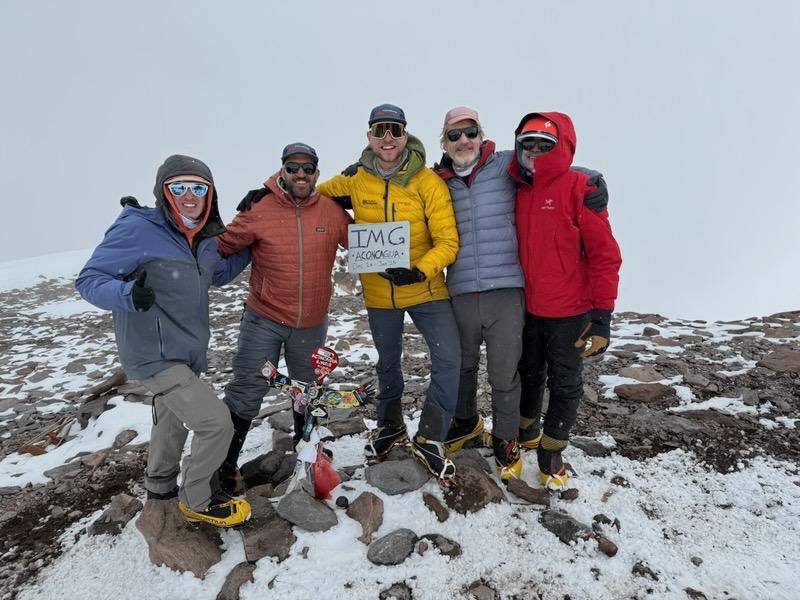January 15th, 2025
IMG’s first Aconcagua program just wrapped up. Led by Stu Johnson and Tincho Lucero, the team had a successful trip, reaching the summit despite snowy conditions. Stu shared his experience guiding the trip with the following summary:
The feeling of climbing into the sky is difficult to describe, but it is one our team felt as we climbed through different layers of clouds to just under 23,000 feet and the summit of the tallest peak outside of Asia – Aconcagua in the Argentinian Andes.
After 11 days of the expedition, we could climb no higher. We began at Puntas de Vacas, where a shipping container houses the park ranger station. The setting is dusty, yellow, beige, with bursts of green from the sharp clumps of the spiked Yareta plant. We followed the Vacas Valley for three days, slowly acclimatizing and working our way towards the base camp – Plaza Argentina. The mules and yellow-capped Sierra finches are constant companions at the lower elevations. At night, we dine in geodesic dome tents; Argentinian barbecue fuels us as the air gets thinner. We walk from the domes to our tents under a vivid night sky.
Once at Plaza Argentina, we rest, continue to eat to our hearts’ (and stomachs’) content, and give our bodies time to adapt to 14,000 feet. The jagged, dark peaks rip the sky open around us, and the Polish Glacier is poised imposingly on the skyline that leads to the summit massif.
We began our sequence of gear carries and camp moves: strategically covering ground, giving it up, only to ascend again the following day. Following the sage advice of climb high, sleep low, we made our way ever upwards. The weather remained agreeable until Camp 2 (Guanacos Camp), with piercing blue skies and the kind of wind that cools you off when you need it. On our rest day at Camp 2, wisps of clouds began to grow around the summit – condensing quickly into dark airships that blocked out the sun. Shortly after, they let loose their artillery on our little camp, and the snow began to accumulate around our tents.
Tincho and I studied the weather and saw a break in the week-long high-pressure system – a day when the skies were open, the winds gentle, and the temperatures moderate. Our team was strong, and the route was snow-covered, which made for slightly quicker movement over a firm and predictable surface. With that information in hand, we moved to Camp Colera at 19,600 feet on the afternoon of the 9th.
We woke up to dazzling stars and the Milky Way painted across the night sky. By 5:30am we were moving up, and after 10 hours and 45 minutes of hard work and determination, we stood on top. We were in the clouds. Pockets of sun broke through, the clouds ebbed and flowed around us, breathing us in and condensing on our skin. We snapped our photos and let gravity assist us down.
Back at camp, we disappeared into our down sleeping bags, ate some ramen, and slept well. The following morning, we broke camp, descended over 5000 feet in just over two and a half hours, and were back in the relatively nutritious air of 14,500 feet, this time on the other side of the mountain at the base camp Plaza de Mulas. The next morning, we cruised downhill for 16 miles and were back at the road, completing an up-and-over of the mighty Aconcagua. An expedition worth experiencing by all!

